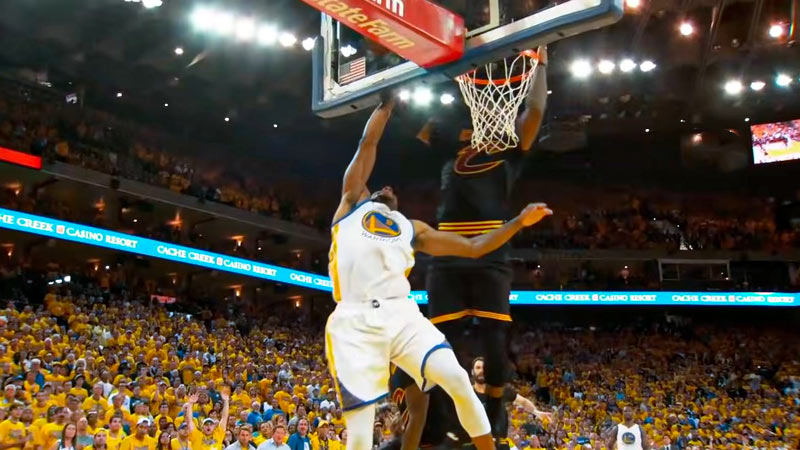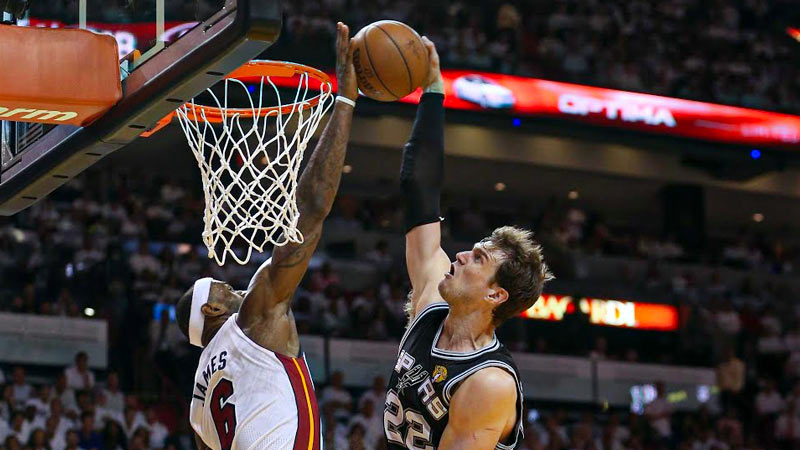Basketball is a game filled with exciting plays, and one of the most thrilling moments for players and fans alike is when a shot is blocked. To understand the term better, you must learn what is Blk in basketball.
The term “BLK” is commonly used in basketball statistics to represent blocks. Blocks are defensive plays where a player jumps to prevent an opponent’s shot from reaching the basket.
In this article, we will delve into the significance of blocks in basketball and explore various aspects related to BLK.
What Is BLK in Basketball?
In basketball, “BLK” typically refers to a blocked shot. A blocked shot occurs when a defensive player successfully prevents an opponent’s field goal attempt by deflecting or swatting the ball away, either during the shooting motion or while the ball is on its way to the basket.
The defensive player’s action is commonly referred to as a block, and it is recorded as a statistic in basketball games to measure a player’s defensive prowess. The number of blocks a player accumulates is often denoted as “BLK” in statistical summaries or player profiles.
Why Is BLK Important in Basketball?
Blocked shots, or “BLK,” are important in basketball for several reasons:
Defensive Presence
Blocked shots are a clear indicator of a player’s ability to protect the rim and defend the basket. A player who excels in blocking shots can disrupt opposing offenses, alter their shot selection, and create a psychological advantage by intimidating opponents from attempting shots in the paint.
Shot Alteration
Even if a blocked shot doesn’t occur, the threat of a potential block can cause offensive players to adjust their shots. This alteration can lead to lower shooting percentages, as players rush or change their shooting form to avoid being blocked.
Defensive Stops
Blocked shots often result in turnovers or missed shots, which give the defensive team possession of the ball. By denying scoring opportunities, blocked shots contribute to defensive stops and help teams regain possession.
Transition Offense
A blocked shot can trigger a fast break or transition offense for the defensive team. Once a block occurs, the defending players can quickly transition from defense to offense, utilizing the momentum swing to create scoring opportunities before the opposing team has a chance to set up their defense.
Team Morale
Blocked shots can be energizing for both the player who executes the block and the team as a whole. They serve as a visual representation of a player’s defensive effort and can boost the team’s morale, inspiring them to intensify their defensive efforts and elevate their overall performance.
Statistic and Evaluation
Blocked shots are a statistical category that allows for the comparison of players’ defensive abilities. Coaches, scouts, and analysts use this statistic to evaluate individual players and their impact on the game, as well as to assess team defense.
How Blocks Are Recorded in Basketball Statistics?

In basketball, blocks are recorded as a statistical category to measure a player’s defensive performance. Here’s how blocks are typically recorded in basketball statistics:
Individual Blocks
An individual block is credited to a specific player who successfully deflects or blocks an opponent’s shot. To be counted as a block, the defensive player must make contact with the ball and prevent it from entering the basket or significantly alter the shot attempt.
The defensive player receives credit for the block in their personal statistics.
Team Blocks
In addition to individual blocks, teams also have block statistics. A team block is recorded when any player on the team blocks a shot. Team blocks represent the total number of blocked shots accumulated by all players on a team during a game.
Statistician’s Discretion
In some cases, the determination of a block can be subjective, especially when it comes to judging whether the defensive player’s action meets the criteria for a block.
Statisticians or scorekeepers at games are responsible for recording blocks and use their judgment to determine whether a block occurred based on the game’s circumstances.
Recording the Number of Blocks
The number of blocks a player accumulates throughout a game is typically displayed in the box score and individual player statistics. It is commonly denoted as “BLK” or “Blocks” followed by the numerical value.
Impact on Other Statistics
Blocks are not only recorded as a standalone statistic but also have an impact on other statistics. For example, a blocked shot can result in a turnover, which would be recorded as a steal for the defensive player who recovered the ball.
Additionally, blocks can contribute to defensive rating calculations, player efficiency ratings, and advanced defensive metrics used for player evaluation and analysis.
BLK as a Statistic: Analyzing Block Leaders
Shot-blocking specialists play a crucial role in basketball defenses. Their ability to consistently block shots can be a game-changer by deterring opponents from attacking the rim and altering their shot selection.
Shot-blocking specialists provide an intimidating presence near the basket, forcing opposing players to think twice before attempting shots in their vicinity.
Even if they don’t record a block on every possession, their reputation and ability to challenge shots can disrupt the offensive flow and lead to lower shooting percentages for opponents.
Recognizing Defensive Impact Beyond Block Numbers

While blocks are a valuable statistic, they do not provide a complete picture of a player’s defensive impact. A player’s defensive contributions extend beyond the number of blocks they accumulate.
Factors such as contesting shots, altering the trajectory of shots, and forcing opponents into difficult shots can all have a significant defensive impact, even if they don’t result in a block.
Evaluating a player’s defensive prowess requires considering their positioning, communication, help defense, on-ball defense, and overall defensive awareness.
Combining Blocks with Other Defensive Metrics
To gain a comprehensive understanding of a player’s defensive abilities, it is essential to combine block statistics with other defensive metrics. This approach helps evaluate a player’s overall defensive impact and provides a more complete picture of their defensive performance.
Some other defensive metrics that can be considered alongside blocks include steals (STL), defensive rebounds (DRB), deflections, charges drawn, opponent field goal percentage at the rim, individual defensive rating, and team defensive rating.
Techniques and Strategies for Effective Shot Blocking
Effective shot blocking in basketball requires a combination of technique, timing, anticipation, and court awareness. Here are some techniques and strategies that can help improve shot-blocking skills:
Positioning and Footwork
Proper positioning and footwork are essential for shot-blocking. Maintain a balanced stance with your feet shoulder-width apart, ready to move quickly. Anticipate the opponent’s moves and position yourself between them and the basket to cut off their driving lanes.
Timing and Anticipation
Shot blocking is as much about timing as it is about athleticism. Develop a sense of timing to anticipate when the offensive player will release the ball. Watch their shooting motion, arm extension, or body positioning to determine the right moment to go for the block.
Verticality
When contesting a shot, focus on going straight up while jumping vertically. Keep your arms extended upward without leaning forward or initiating unnecessary body contact.
This technique, known as verticality, reduces the chances of drawing a foul and forces the offensive player to shoot over your outstretched arms.
Shot Selection Awareness
Be selective when choosing which shots to block. Prioritize blocking shots that are closer to the basket or shots from players with a lower shooting percentage. Avoid unnecessary risks by recognizing situations where it’s more beneficial to contest the shot without attempting a block.
Hand-eye coordination and Ball Tracking
![]()
Develop hand-eye coordination to track the flight of the ball. Keep your eyes on the ball while maintaining awareness of the offensive player’s movements. This allows you to react quickly and make precise timing adjustments to block or alter the shot.
Communication and Help Defense
Effective shot blocking often involves team coordination. Communicate with your teammates to alert them when you’re in a position to block a shot, allowing them to rotate and cover potential offensive threats.
Understanding defensive rotations and providing help defense can increase the likelihood of successful shot blocks.
Study Opponents and Develop Scouting Reports
Research and study the tendencies and shooting techniques of opposing players. Recognize their preferred shooting spots, shooting motions, and tendencies when driving to the basket. This knowledge enables you to anticipate their moves and positions you for better shot-blocking opportunities.
Avoid Overcommitting
While shot blocking is an essential defensive skill, it’s important not to overcommit and leave your defensive assignment vulnerable. Maintain discipline and balance between shot blocking and staying in a position to prevent easy baskets or open passing lanes.
Recovery and Transition Defense
If a shot block attempt is unsuccessful, quickly recover and transition back to defense. Sprint back to your position to prevent fast break opportunities for the opposing team.
Practice and Repetition
Like any skill, shot-blocking requires practice to improve timing, coordination, and technique. Incorporate specific shot-blocking drills into your training regimen to enhance your skills in a game-like scenario.
Remember, shot-blocking should be executed within the context of team defense and should not compromise your overall defensive responsibilities. Effective shot blocking can provide a significant advantage for your team, but it’s crucial to balance it with solid positioning, awareness, and overall defensive principles.
FAQs
How are blocks different from steals in basketball?
Blocks and steals are both defensive actions in basketball, but they differ in execution. Blocks occur when a defender jumps to prevent an opponent’s shot from reaching the basket, while steals happen when a defender legally takes possession of the ball from an opposing player by intercepting a pass or disrupting their dribble.
Can any player become proficient at shot blocking?
While shot-blocking requires athleticism and timing, any player can improve their shot-blocking skills with practice and proper technique. However, certain physical attributes such as height, wingspan, and leaping ability can provide an advantage when it comes to shot-blocking proficiency.
Are blocks considered a positive statistic for individual players?
Yes, blocks are generally viewed as a positive statistic for individual players. Blocks demonstrate a player’s defensive presence and ability to protect the rim, which is highly valued in basketball.
However, it’s important to note that blocks alone do not provide a complete picture of a player’s defensive abilities, and other factors such as positioning, communication, and overall defensive impact should also be considered.
Who holds the record for the most blocks in NBA history?
As of my knowledge cutoff in September 2021, Hakeem Olajuwon holds the record for the most blocks in NBA history. Olajuwon accumulated an impressive total of 3,830 blocks over his career, showcasing his exceptional shot-blocking abilities and defensive prowess.
Are blocks more effective at disrupting opponents or intimidating them?
Blocks can have both a disruptive and intimidating effect on opponents. When a shot is blocked, it disrupts the offensive player’s intended scoring attempt, potentially leading to a turnover or missed shot. Additionally, the act of shot blocking can intimidate opponents, making them more hesitant to attack the basket or altering their shooting technique to avoid getting blocked.
Bottom Line
Now you know what is Blk in basketball. Blocks in basketball can change the momentum of a game and electrify the crowd. They are not only a defensive strategy but also a statement of dominance and intimidation.
Shot blockers have left an indelible mark on the sport, and their contributions continue to be celebrated. Understanding the importance of blocks, both as a defensive tactic and as a statistical category, enhances our appreciation for the game and the players who excel in this aspect.
Overall, blocked shots play a crucial role in basketball by impacting the defensive strategy, altering shots, creating turnovers, generating transition opportunities, boosting team morale, and providing a measurable indicator of defensive prowess.







